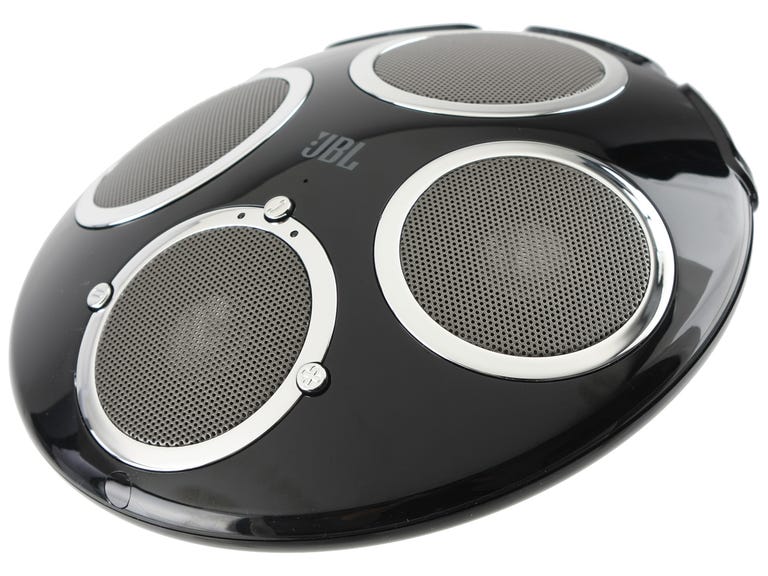 Why You Can Trust CNET
Why You Can Trust CNET JBL On Tour XTB review: JBL On Tour XTB
JBL On Tour XTB
No picnic, barbecue, or other group activity is complete until you introduce music, but the problem with portable speakers is that you either have to find an outlet for power or the speakers themselves are so poor that all you can hear is a garbled mess. The JBL On Tour XTB system makes a convenient accessory for summer activities; sound quality is top notch even at loud volumes and it can connect wirelessly through Bluetooth, but its slightly overpriced at $200. We stand behind the On Tour XTB if you can afford it, but if you're just looking for a basic, portable speaker, you and your wallet will get more satisfaction out of the $100 Philips SBD7500.
The Good
The Bad
The Bottom Line
At first glance, you might mistake the On Tour XTB for a smaller version of the popular Roomba vacuum cleaner, but the four speakers mounted on top of the unit give it away. We like the size of the XTB; at 6 inches wide, 6 inches tall, and 2.5 inches thick, the speaker won't become an obstruction in your travel bag. The exterior is covered in a glossy black finish and each of the four drivers is wrapped in a shiny chrome border for extra style points.
One of the speakers on top of the device features two volume buttons on either side and a small button on top that answers your phone if you have it connected via Bluetooth. There's no mic built into the speaker, but you can use it as a speakerphone along with your handset.
JBL puts all the other buttons including power, audio-in, and DC power ports on the opposite edge of the On Tour XTB, and Appleheads will certainly appreciate the extra USB port thrown in for charging your iPods and iPhones on the run.
Our issue with the physical design is that there's no indicator to go along with the two separate volume control buttons. JBL could have avoided this problem by simply using a one-piece volume dial or even a small LED, but as it stands there's no way to gauge volume settings aside from trial and error. The system also comes with a cheap plastic remote control that lets you control volume and playback.
Underneath the speaker you'll find five rubber feet that keep the device from sliding around on a tabletop as well as a rotating door that lifts up to uncover the battery compartment. The On Tour XTB takes four AA batteries and also accepts rechargables which, when paired with a Bluetooth device, allows for a truly cordless experience. JBL also gives you a separate AC adapter so you can plug it in at home.
You can connect the speaker to any audio source using the included line-in cable, or you can also pair them together with Bluetooth. Using JBL's simple instructions and a four-digit code, we established a connection using several different Bluetooth phones (including an iPhone 3GS and a Palm Pre) in less than 5 minutes. To streamline your uninterrupted listening experience, JBL also lets you answer, ignore, and switch lines using the aforementioned phone button on the speaker.
We should also point out that the On Tour XTB adheres to two modern advancements in Bluetooth technology: the Advanced Audio Distribution Profile (A2DP) allows for full stereo audio, and the Audio/Video Remote Control Profile (AVRCP) is also enabled for complete remote control using an external audio device, although Apple products won't allow volume controls to appear in the Bluetooth music-streaming mode for now. Obviously we won't ding JBL for Apple's protocols, but keep in mind that you'll have to walk back to the speaker to change the volume if you plan to use it with an iPhone 3G or 3GS. Strangely enough, Apple lets you change the ringer and call volume in Bluetooth calling mode.
Inside the unit you'll find four Odyssey neodymium drivers powering the speakers at 8 watts per channel, producing an impressive sound for such a small gadget. Keeping in mind the degradation of audio quality over a Bluetooth connection, we put the speakers through a variety of sound tests that included tracks from hip-hop, pop, metal, and jazz groups and were pleased with the outcome. Of course the emphasis on bass is much more subtle than with most desktop computer speakers, but these produced excellent clarity and instrument distinction even at maximum volume, certainly loud enough (maybe even too loud) for the average backyard party.
We also came away pleased with the quality of sound from the 3.5mm line input. The sound quality is slightly better than the Bluetooth connection, which is expected, but we expect most users will accept the trade-off with very little, if any, disappointment.


